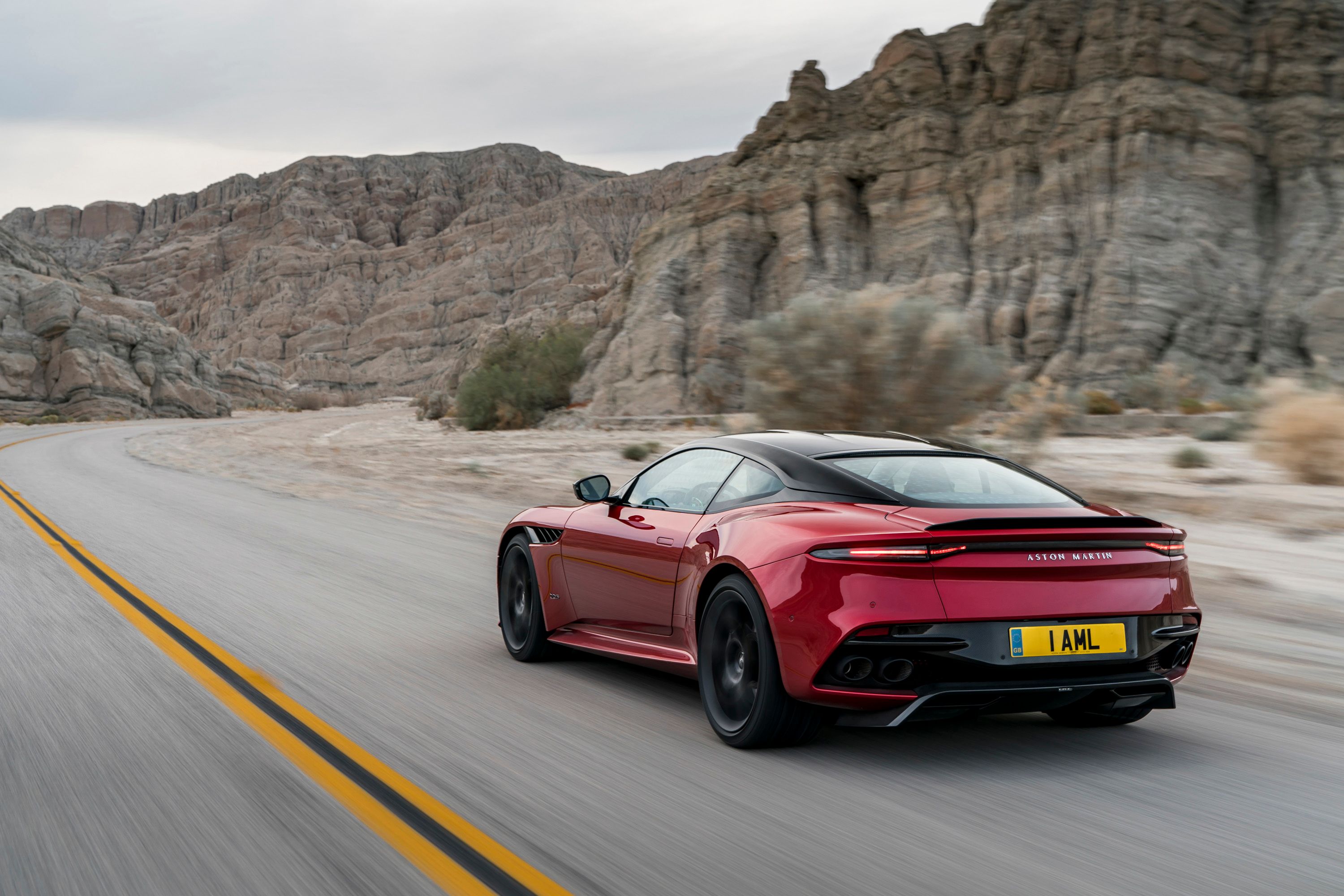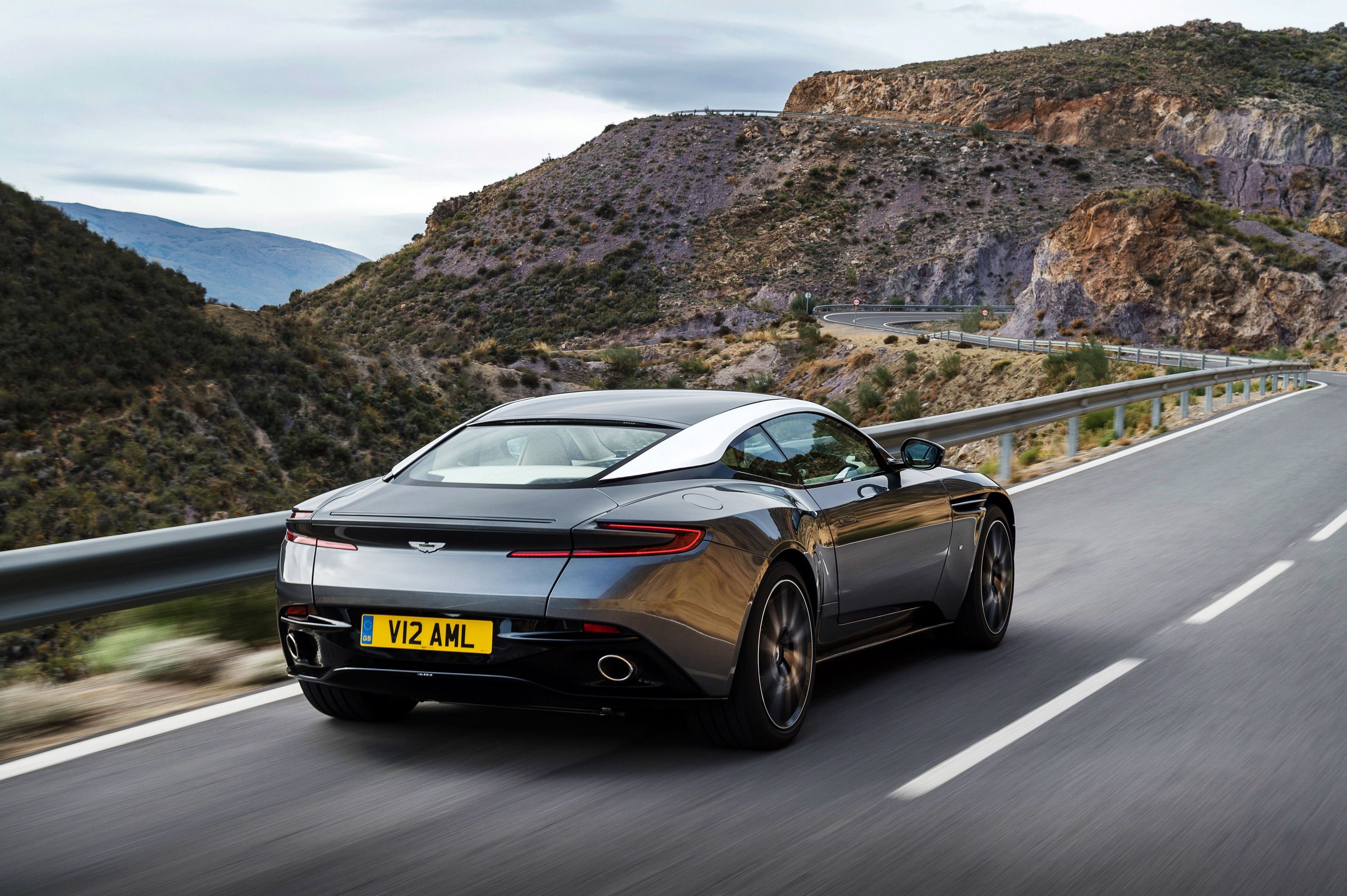Aston’s latest addition to the world of high-end speed is the DBS Superleggera, a V-12-powered range-topping super GT flagship. This thing is one big, bad monster machine, but peel back the sultry body pieces, and you’ll find the Aston Martin DB11, which provides both the underpinnings and many of the mechanical bits. So then, how do they compare?
Continue reading for the full story.
2019 Aston Martin DBS Superleggera vs. Aston Martin DB11 Exterior
|
|
ids=785439,785444 |
no_overlay=true> |
Note: 2019 Aston Martin DBS Superleggera pictured on the left, Aston Martin DB11 pictured on the right.
Lets kick things off with the DBS Superleggera, which brings a new exterior design to the platform to help it stand out next to the DB11. The most obvious difference is up front, where the fascia gains a mammoth new intake spread across the front bumper. While the shape is close to that of the DB11, the intake on the DBS Superleggera is significantly larger in size, and comes complemented by a set of side intakes to help gulp down even more air. The hood is also redesigned with new vents, as are the fenders, while the headlight housings get a reshape as well.
The side silhouette is close in shape, with cab-back proportions and a long hood line, but the DBS Superleggera looks longer and lower than its DB11 counterpart. In back, the DBS Superleggera gains restyled taillights, as well as a quad exhaust compared to the DB11’s dual setup.
The DBS Superleggera’s individual aero elements all come from the DB11, and include standouts like the “curlicue” and “AeroBlade,” but they’re far more pronounced on the new flagship model. The DBS Superleggera also incorporates an F1-inspired double splitter up front. All told, the DBS Superleggera produces as much as 180 kg (397 pounds) of downforce, the most of any production vehicle Aston has ever built.
Final touches include two wheel designs in six unique finishes, all of which offer lightweight construction and a 21-inch diameter. There’s also loads of customization options to spec yours as you see fit.
|
|
ids=785441,785443 |
no_overlay=true> |
Overall, the DBS Superleggera looks like a more aggressive, more exotic evolution of the DB11, which is exactly as it should be. The design cues are obvious when placed next to the preceding DB9 model, as all three share the same DNA.
And while the DBS Superleggera is certainly the more striking option, the DB11 still has all the right components to make it feel special. For example, there’s still a front-hinged clamshell hood, LED headlights, and sculpted taillights, while the aero components function to keep the car both streamlined and glued to the road (the curlicue moves air from inside the wheel arch through the side strake vents, while the AeroBlade “virtual spoiler” directs air through intakes on the C-pillar through ducts in the body, venting through the rear deck lid). Throw in a plethora of customization options, and buyers are sure to be pleased with the aesthetics and aero functionality of every model in the range, be it the range-topping DBS Superleggera, or the base model DB11.
|
|
Aston Martin DBS Superleggera |
Aston Martin DB11 |
|
Length |
4,712 mm (185.51 inches) |
4,739 mm (186.57 inches) |
|
Width |
2,146 mm (84.48 inches) |
2,060 mm (81.10 inches) |
|
Height |
1,280 mm (50.39 inches) |
1,279 mm (50.35 inches) |
|
Wheelbase |
2,805 mm (110.43 inches) |
2,805 mm (110.43 inches) |
2019 Aston Martin DBS Superleggera vs. Aston Martin DB11 Interior
|
|
ids=785052,667778 |
no_overlay=true> |
Note: 2019 Aston Martin DBS Superleggera pictured on the left, Aston Martin DB11 pictured on the right.
Anyone who’s seen a cabin picture of the DB11 is sure to recognize the interior of the DBS Superleggera. The look and layout is nearly identical, with a broad, sweeping dash, oblong center console, and horizontal gauge pod.
Look closely, though, and you’ll find a few relatively subtle differences. For example, the gauge pod surround in the DBS Superleggera is far more intricate and technical in its appearance, with larger dividers breaking it up into three defined sections from left to right. The steering wheel is also different, offered with a more angular, geometric design in the DBS Superleggera, and the seats are more aggressively bolstered in the range-topping model.
Standard equipment in the DBS Superleggera includes standouts like keyless entry and a 360-degree parking camera with park assist and a distance display. A DAB audio system provides the tunes, and comes with complementary Bluetooth support, phone streaming, iPod and USB playback, and an integrated satellite navigation system, not to mention a Wi-Fi web connection.
Infotainment feedback is provided by an LCD screen mounted in the dash, while plenty of hide and Alcantara upholstery covers the various surfaces. Like the exterior, buyers get copious customization options to make theirs their own, especially with regards to the color scheme.
Meanwhile, the DB11 comes with the same 12.0-inch TFT LCD display behind the wheel, as well as the same 8.0-inch TFT screen in the dash. Standard spec includes a rotary control on the console and an optional touchpad. Auto-park and a 360-degree around-view camera are also offered, just like on the DBS Superleggera. Finally, Nexus quilting and Celestial perforation add to the leather upholstery spec, and there are still tons of customization options to choose from.
Note: 2019 Aston Martin DBS Superleggera pictured on the left, Aston Martin DB11 pictured on the right.0}
|
|
ids=785042,667795 |
no_overlay=true> |
Note: 2019 Aston Martin DBS Superleggera pictured on the left, Aston Martin DB11 pictured on the right.
Just like the DB11, the DBS Superleggera rocks a front-engine, RWD drivetrain layout headlined by a twin-turbo 5.2-liter V-12. However, output from this meaty twelve-cylinder sees a significant jump in the DBS Superleggera, as Gaydon’s engineers massaged it up to 715 horsepower at 6,500 rpm and 900 Nm (664 pound-feet) of torque between 1,800 and 5,000 rpm.
Properly motivated, the DBS Superleggera will hit 62 mph from a standstill in 3.4 seconds and 100 mph in 6.4 seconds. Put it in fourth gear and mash it at 50 mph, and you’ll see 100 mph in 4.2 seconds. Keep your foot pinned, and it’ll top out at 211 mph.
And don’t worry - they’ll hear ‘ya coming thanks to the DBS Superleggera’s new exhaust and active valve system, which provides different decibel levels and tones depending on the mode you’ve selected.
An eight-speed automatic transmission from ZF sends it all to the rear axle, and comes with a lower final drive for greater acceleration. A mechanical limited-slip differential makes extra traction, while an advanced torque vectoring system helps drivers power out of corners.
Under the carbon fiber body panels is an evolution of the same bonded aluminum structure found in the DB11. To enhance its dynamic prowess, Aston says the engine was mounted as low and far back in the chassis as possible, while the transmission was mounted in the rear, all of which results in optimized weight distribution and a lower the center of gravity. Forged double wishbones in front and a multi-link in the rear handle the remaining heft, and an adaptive damping system comes as standard, with a variety of sensors onboard to make it all work. Pirelli rubber wraps the wide lightweight wheels in the corners.
Compared to the DBS Superleggera, the DB11 is a bit down on power, but definitely anything but slow, creating as much as 600 horsepower at 6,500 rpm and 700 Nm (516 pound-feet) of torque at 1,500 rpm. That’s 115 horsepower and 148 pound-feet less than the DBS Superleggera, which adds a few tenths to the 0-to-62 mph time (3.9 seconds) and cuts into the top speed (200 mph).
However, the DB11 still comes with the same driving modes as the DBS Superleggera, which includes GT, Sport, and Sport Plus, all of which affect the throttle response, transmission settings, steering settings, torque vectoring system, and adaptive damping suspension settings.
DB11 buyers content with going “fast” (as opposed to “insanely fast”) can alternatively go with the base model twin-turbo 4.0-liter V-8, which produces 503 horsepower and 513 pound-feet of torque, yielding a 0-to-62 mph time of 4 seconds flat and a top speed of 187 mph. The V-8 model is also lighter, cutting 253 pounds from the V-12 DB11’s 4,133 pounds for a curb weight of 3,880 pounds, which sits just above the DBS Superleggera’s 3,733-pound curb weight.
|
|
Aston Martin DBS Superleggera |
Aston Martin DB11 |
|
Engine |
All-alloy quad overhead cam, 48-valve 5.2-litre bi-turbo, V12 with stop/start cylinder deactivation |
All-alloy quad overhead cam, 48 valve, 5.2-litre twin-turbo V12 |
|
Cooling |
Water-to-air Charge |
Charge Cooling |
|
Drive |
Front mid-mounted engine, rear-wheel drive |
Front mid-mounted engine, rear-wheel drive |
|
Compression ratio |
9.3:1 |
9.2:1 |
|
Maximum power |
715 HP @ 6,500 RPM |
600 HP @ 6,500 RPM |
|
Maximum torque |
663 LB-FT @ 1,800-5,000 RPM |
516 LB-FT @ 1,500-5,000 RPM |
|
Acceleration 0-62mph (0-100km/h) |
3.4 seconds |
3.9 seconds |
|
Maximum speed |
211mph |
200 mph |
|
Transmission |
Rear mid-mounted ZF eight-speed automatic |
Rear mid-mounted ZF eight-speed automatic gearbox with electronic shift-by-wire control system |
2019 Aston Martin DBS Superleggera vs. Aston Martin DB11 Performance
|
|
ids=785445,785446 |
no_overlay=true> |
Note: 2019 Aston Martin DBS Superleggera pictured on the left, Aston Martin DB11 pictured on the right.
The DBS Superleggera starts at $304,995, with deliveries kicking off in Q3 of this year. Meanwhile, the DB11 starts at $198,995 for the V-8, and $216,495 for the V-12.
Note: 2019 Aston Martin DBS Superleggera pictured on the left, Aston Martin DB11 pictured on the right.0}
|
|
ids=785448,785447 |
no_overlay=true> |
Note: 2019 Aston Martin DBS Superleggera pictured on the left, Aston Martin DB11 pictured on the right.
So, now that we’ve covered both vehicles in-depth, what does the DBS Superleggera offer over the standard V-12 DB11 for that extra $88,500?
Outside, the DBS Superleggera is more aggressive and more exotic in its appearance, with bigger aero, larger intakes, and flared features that demand attention, not to mention extra downforce while traveling at speed.
Inside, the differences are less obvious, but you still get new seats, a new gauge pod, a new steering wheel, and more standard equipment.
However, the really big ticket item is under the hood. Adding an extra 115 horsepower and 148 pound-feet of torque to the already potent 600-horse, 516-pound-foot V-12 is a bit zany, but the result is nothing less than a true GT supercar. The 0-to-60 mph times might be relatively close between both models, but that’s simply a traction issue. The real difference will be felt when laying into it at freeway speeds, for example, that 4.2-second 50-to-100 mph time Aston quoted for the DBS Superleggera.
Throw in significant weight savings and an optimized chassis and handling system, and the DBS Superleggera is shaping up to be a true performance monster.
However, does all that justify spending an extra $90,000, which is basically the MSRP of a brand-new Lexus LC 500? For some, the answer is an unequivocal “yes.”
You see, the DBS Superleggera is for those buyers who want nothing but the best, the very finest that money can buy. Few can reason their way to buying a machine like this, but that’s half the point. The DBS Superleggera is about more than just sheer, unbridled speed - it’s also about bragging rights, and in that sense, it excels.
2019 Aston Martin DBS Superleggera vs. Aston Martin DB11 Pricing
Note: 2019 Aston Martin DBS Superleggera pictured on the left, Aston Martin DB11 pictured on the right.
Note: 2019 Aston Martin DBS Superleggera pictured on the left, Aston Martin DB11 pictured on the right.
Read our full review on the 2019 Aston Martin DBS Superleggera.


